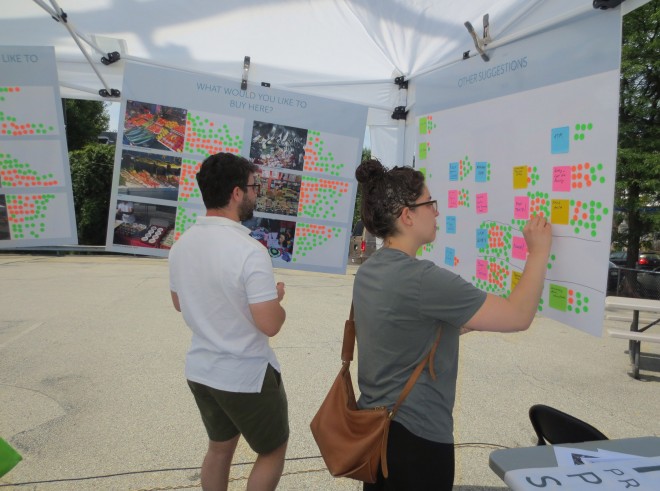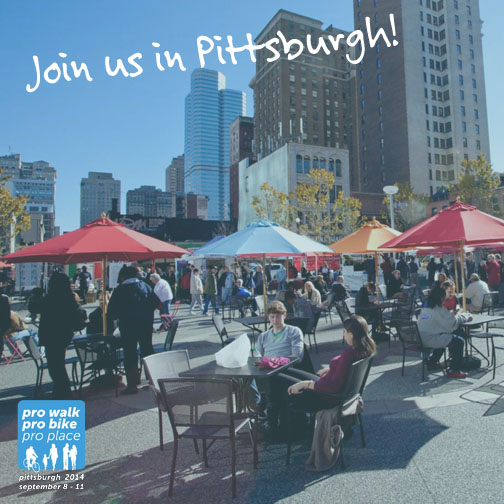A biweekly newsletter with public space news, resources, and opportunities.
A curated dispatch on all things public markets plus the latest announcements from the Market Cities Program.

Pittsburgh has done it again! After being named "America's Most Livable City" by Forbes in 2010 and one of the “Best All-American Vacations” earlier this year by The Travel Channel, it was recently named as the second "most livable city" in the United States by the Economist Intelligence Unit's 2014 livability survey, keeping up with its prior rankings on this infamous list.
We've written before on the great things to do in Pittsburgh, but the "City of Champions" has been more than just a hot topic here at PPS. In fact, we've been involved in Pittsburgh for some time now, most notably during the last year in the run up to the upcoming Placemaking Leadership Council and Pro Walk/Pro Bike/Pro Place conference this September. Pittsburgh is ripe for Placemaking and our recent work there has been an inspiration for everyone, making it the perfect host city for this seminal gathering of Placemaking leaders and walking and bicycling professionals. Here's a peek into what we've been doing to get you excited about what's to come.
Ahead of the upcoming Pro Walk/Pro Bike/Pro Place conference in 2014, an invite-only meeting was held in 2013 hosting 200 regional leaders and national experts in the bicycling, walking, and Placemaking community. The goal was to discuss: how to improve regional mobility by better biking accessibility; how to improve neighborhoods and individual health by better and safer walking linkages; and how to activate Pittsburgh’s public spaces through Placemaking. Led by keynote speaker Mark Gorton, social entrepreneur and founder of Streetsblog, and the soon-to-be Mayor Peduto, this stellar group set the stage for 2014, and discussed how to make Placemaking and active transportation projects in the Pittsburgh area happen.

This past July, we conducted another similar workshop sponsored by the CMU Remaking Cities Institute and The Design Center, with funding by the Bayer Foundation. The workshop included more than fifty members of various organizations in Pittsburgh, from AARP to the local Better Block group. Using Carnegie Mellon's campus as an example, six teams were guided through the Place Game - one of our most important tools for analyzing public space - in sections of the main lawn, the major intersection nearby, and walkways leading to important buildings like the Welcome Center and Bookstore.
Many Lighter, Quicker, Cheaper recommendations came out of the assessments, including flexible seating, more plantings, food and drink kiosks, improved crosswalks, and partnerships with local student organizations, all aimed towards creating the feeling of an outdoor "living room" in this otherwise wide open space. Long term improvements could include widening sidewalks, making signage more apparent, traffic calming, outdoor performances, bike lanes, better transit stops, and even an amphitheater. The results were given to the university, and attendees took the training with them to their respective groups.

What if we reinvisioned a bus stop to be a vibrant public place and not just a sterile structure? Buses in Pittsburgh are critical to communities as centers for not only access to transit, but social hubs as well. Later that same month, two of our transportation associates teamed up with interns working with the City Planning department in Pittsburgh to gather public opinions on how to liven up the local bus stops in the Hill District. Through surveys and exercises, they engaged with the community in this disadvantaged area to learn more about what works, what doesn't, and how they feel the space could be improved.
Overall, people felt positively about the engagement and had quite a lot to say about this space they use so frequently. Several respondents mentioned that they met their wives there, that they talk to fellow riders, and that people smile at one another. However, a lot could also be improved upon. Residents would like to see more (and more comfortable) seating, maps of transit routes, and climate control through enclosed shelters or fans.
During the Pro Walk/Pro Bike/Pro Place conference, several activations are also planned as part of one of the many workshops taking place September 8-11th. In the Hill District, the local YMCA will be programming the nearby bus stops with healthy interventions that people can use while waiting for the bus, and the local Public Library will be adding miniature libraries to bus stops with seating areas where they can read while they wait. Downtown, the Historical Society will be doing demonstrations at the bus stop by the convention center where the conference is being held so that attendees can experience this as well.

On August 15-16, Kate Rube and Kelly Verel at PPS visited Pittsburgh's Bloomfield neighborhood as part of PPS's Healthy Placemaking initiative. Bloomfield, Pittsburgh's "Little Italy," is home to a number of vibrant, independent shops and small businesses and a brand new Saturday morning farmers market located in an empty parking lot off of Liberty Avenue, the neighborhood's main commercial street, which is anchored by West Penn Hospital. The Bloomfield Development Corporation, whose mission is to support economic development and improve the quality of life for residents, started a farmers market at the end of May 2014, with support from a number of local health providers and businesses, to create a great gathering space for residents, highlight local and regional small businesses, and provide the community access to fresh food and health and nutrition information.
PPS was first introduced to the BDC and their Saturday Market through Pittsburgh's Design Center. Working with the Design Center and the staff of the BDC, PPS hosted a stakeholder workshop on August 15 and solicited input from the public at the newly developed Bloomfield Saturday Market on August 16. While the market has been extremely successful in its first year - growing from 18 to 29 vendors and attracting almost 1000 customers per market day - the BDC was still interested in incorporating more activities and health-related uses at their market. Participants at both events expressed interest in a number of uses and activities including cooking demonstrations, live music, a book swap/mobile library, and more comfortable places to sit, eat and gather. Enthusiasm was strong from customers and vendors alike in the market. PPS's next step is to consolidate the stakeholder and community input into a report for the BDC, which will also describe and show how the market can accommodate more healthy uses and activities while also presenting a plan for growth.

All of this of course leads to the major event, Pro Walk/Pro Bike/Pro Place, which will be bringing many minds to Pittsburgh, including members of the local community. The idea behind the Open House is to bring the conference to the community. There is lots of enthusiasm for walking, biking, and Placemaking in Pittsburgh, but not everyone can take three days off work to have the full conference experience. The Open House will feature local speakers telling the story of Pittsburgh, and previewing its next chapter. The Open House will also feature Streetfilms University and Mike Lanza, author of Playborhood and Pittsburgh native. If you're in Pittsburgh, we hope to see you there! Check out the flier for more information.
The rich text element allows you to create and format headings, paragraphs, blockquotes, images, and video all in one place instead of having to add and format them individually. Just double-click and easily create content.
The rich text element allows you to create and format headings, paragraphs, blockquotes, images, and video all in one place instead of having to add and format them individually. Just double-click and easily create content.
Body Text Body Link
The rich text element allows you to create and format headings, paragraphs, blockquotes, images, and video all in one place instead of having to add and format them individually. Just double-click and easily create content.
Here is some highlighted text from the article.




Headings, paragraphs, blockquotes, figures, images, and figure captions can all be styled after a class is added to the rich text element using the "When inside of" nested selector system.
Headings, paragraphs, blockquotes, figures, images, and figure captions can all be styled after a class is added to the rich text element using the "When inside of" nested selector system.
Headings, paragraphs, blockquotes, figures, images, and figure captions can all be styled after a class is added to the rich text element using the "When inside of" nested selector system.

We are committed to access to quality content that advances the placemaking cause—and your support makes that possible. If this article informed, inspired, or helped you, please consider making a quick donation. Every contribution helps!
Project for Public Spaces is a 501(c)(3) tax-exempt organization and your donation is tax-deductible within the guidelines of U.S. law.